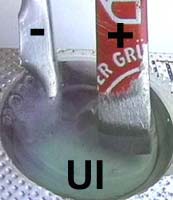 ..
.. ..
..
Photos 8.1 - 8.3
Electrolysis of salt water
with aluminium anode (1) and with iron anode (2 and 3)
8. Electrolysis of table salt solutions with anodes made of Cola two can metals
 ..
.. ..
..
Photos 8.1 - 8.3
Electrolysis of salt water
with aluminium anode (1) and with iron anode (2 and 3)
Experiment 1
: Salt water and one drop of universal indicator solution (UI) are electrolysed
in a the cavity of a blister packing. A strip of sanded cola can
metal (Fe) is used as negative electrode, its closure (Al) as positive
electrode. A strong flow of gas bubbles is observed at the Fe cathode.
The green colour of UI turns to violet (alkaline).
Reduction: 4 H2O(l) + 4
e- --> 2 H2(g) + 4 OH-(aq)
At the Al anode less gas
bubbles come out, the green colour of UI turns to red (acidic).
Oxidation:
2 H2O(l) --> O2(g)
+ 4 H+(aq) + 4 e-
Redox reaction: 2 H2O(l)
--> 2 H2 (g) + O2 (g)
Verification of this interpretation:
The liquids around anode
and cathode are mixed after the end of electrolysis: The colours of UI
return to green again. This proves that equivalent quantities of hydroxide
and of oxonium ions have developed during cathodic reduction and anodic
oxidation. These ions neutralised each other during mixing
Experiment 2 (2
and 3)
In this experiment the electrodes
are exchanged: The tin (Fe) is used as the positive electrode, the closure
(Al) as negative electrode. Both are dipped into the cavity of the blister
packing with salt water + UI again.
Gas bubbles are observed
at the negative electrode (Al). The colour of the UI changes to violet.(alkaline).
Reduction: 2 H2O(l) + 2 e-
--> H2(g) + 2 OH-(aq)
No gas is observed at the
positive electrode (Fe), the UI remains green.
Oxidation:
Fe(s) --> Fe2+(aq) + 2e-
Total reaction: 2 H2O(l)
+ Fe(s) --> Fe2+(aq) + 2 OH-(aq)
+ H2(g).
Verification of this interpretation:
3: The electrolysis
is repeated without UI. The liquids around anode and cathode are mixed:
A green slimy precipitation appears: Fe2+(aq)
+ 2 OH-(aq) --> Fe(OH)2(s)
By adding drops of diluted sulfuric acid this precipitation disappears:
Fe(OH)2(s) + 2 H+(aq) –neutralisation--> Fe2+(aq)
+ 2H2O
Drops of KMnO4
solution lose their colour showing that Fe2+ ions were present:
5 Fe2+(aq)
+ MnO4-(aq) + 8 H+(aq) ---direct
redox reaction --> 5 Fe3+(aq) + Mn2+(aq) +
4 H2O
In order to test for iron(III)
ions two drops of the solution are transferred into two cavities of a blister.
One drop of potassium hexacyanoferrate(II) solution is added to one sample:
A blue precipitate is observed. One drop of ammonium thiocyanate solution
is added to the other sample. A red brown colour appears.